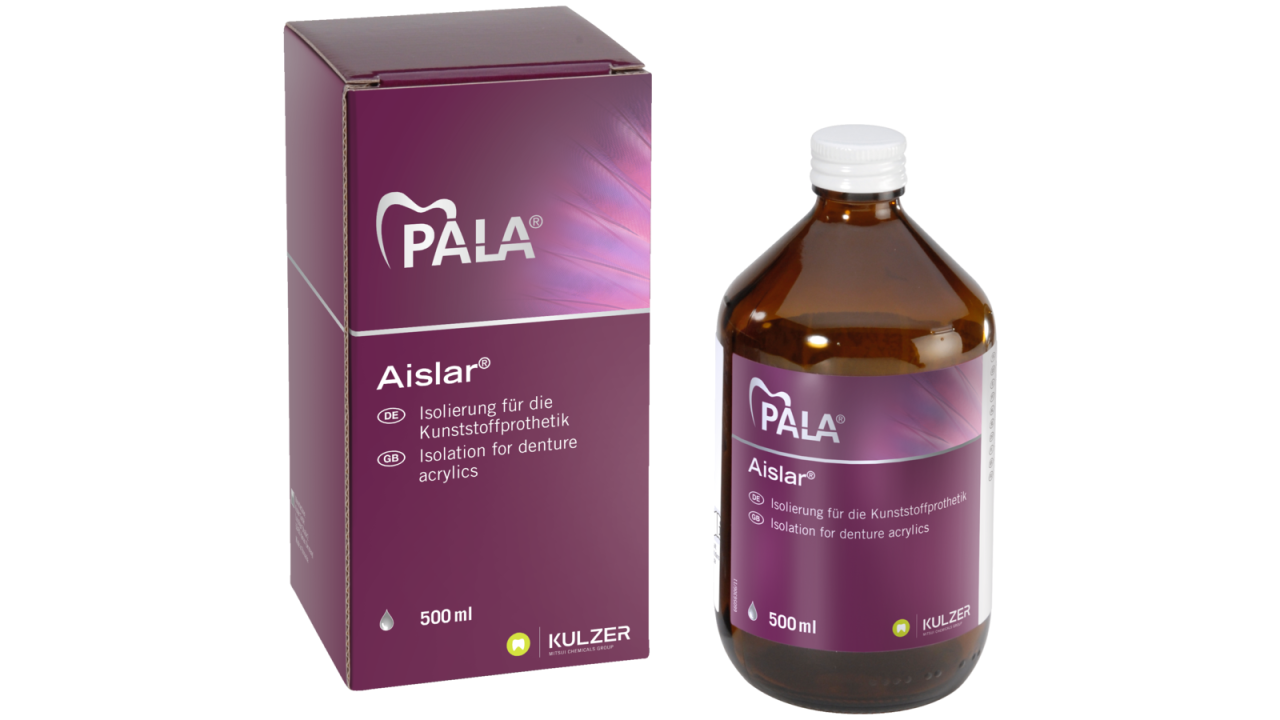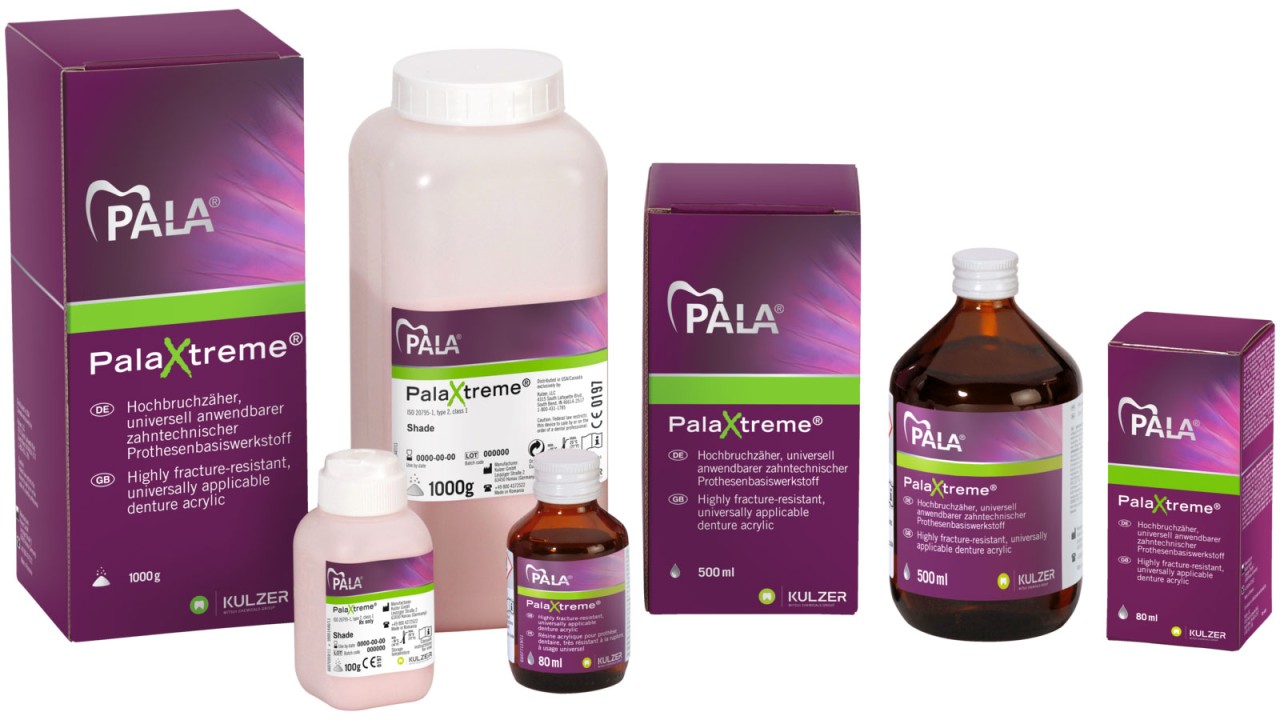Contact Kulzer International
Pala acrylics trouble shooting guide
Bubble formation & porosities
1. Plaster model too dry.
Please refer to IFU of Kulzer Palaferm.
Dried out plaster models must be hydrated with water prior to isolation (depending on the dryness approx. 5 – 15 min).
Watering prevents air bubbles from penetrating the resin during the pressure polymerization process.
2. Insulation not working properly.
Please refer to IFU of Kulzer Aislar.
Do not store above 25°C (77°F). Do not use after expiry date. Avoid direct exposure to sun. When product has been removed, reseal carefully.
Surplus Aislar already poured out must not be returned to the original bottle.
3. Too little acylic dough in injection cylinder (Palajet)
Please refer to the dosage recommendation of IFU of Kulzer Palajet.
4. Wrong polymerization time (too early or delayed insertion into the pressure pot).
Please refer to IFU of Kulzer prosthetic acrylic materials.
Note the longer handlingtime of Palapress vario and PalaXpress.
5. Not enough acrylic material for pack & press technique (Paladon 65).
Please refer to IFU of Kulzer Paladon 65.
Place the dough with excess in the cuvette, slowly close under a press at intervals and leave under pressure for about 10 minutes. If pieces are thick, add small amounts of dough.
6. Heating up too quickly (Paladon 65).
Please follow the instructions for the three possible polymerization methods in the IFU of Kulzer Paladon 65.
White staining, basal
1. Insufficient wax elimination.
Please refer to IFU of Kulzer prosthetic acrylic materials.
Plaster model needs to be completely free of wax residue.
2. Contaminated insulating material.
Please refer to IFU of Kulzer Aislar or Kulzer Palaferm.
Do not store above 25°C (77°F). Do not use after expiry date. Avoid direct exposure to sun. When product has been removed, reseal carefully.
Surplus Aislar or Palaferm already poured out must not be returned to the original bottle.
3. Alcohol based separating agents on plaster / wax model. Oil-based insulating agents.
Please refer to IFU of Kulzer prosthetic acrylic materials.
When positioning teeth in wax, do not use alcohol based separating agents (separation of gypsum and wax), as this may cause white discoloration on the basal surface of the prosthesis.
4. Insulating material for gypsum/plastic still wet - insufficient drying.
Please refer to IFU of Kulzer Aislar or Kulzer Palaferm.
Kulzer Palaferm dries within 2 – 4 minutes depending on the thickness applied and ambient temperature.
After drying the Kulzer Aislar isolation film, the acrylic dough can be inserted immediately.
5. Wrong gypsum class type 1 or type 2 or blue plaster.
Please refer to IFU of Kulzer prosthetic acrylic materials.
Use a type/ class III dental stone for making the model, e.g. Kulzer Octa Dur yellow.
6. Plaster too cold when applying insulation.
Please refer to IFU of Kulzer Aislar or Kulzer Palaferm.
Prolonged drying time of the insulation when the plaster is cold.
Kulzer Palaferm dries within 2 – 4 minutes depending on the thickness applied and ambient temperature.
After drying the Kulzer Aislar isolation film, the acrylic dough can be inserted immediately.
7. Polymerization temperature too low.
Adhere to polymerization temperatures and times according to the current instructions for use of the prosthetic acrylic materials.
8. Swelling time insufficient.
Adhere to swelling time and handling time according to the current instructions for use of the prosthetic acrylic materials.
Irritation of the oral mucosa
1. Rough basal surface.
Follow the instructions for impression taking, insulation and model fabrication. Avoid excessive steaming and scalding of the plaster model.
2. Polymerization time was too short or wrong polymerization temperature.
Please refer to IFU of Kulzer prosthetic acrylic materials.
3. No water storage after completion.
Please refer to IFU of Kulzer prosthetic acrylic materials.
For further risk reduction of intolerance reactions, the denture has to be stored in tepid water for at least 12 hours before placement.
4. Denture freshly relined.
Please refer to IFU of Kulzer prosthetic acrylic materials.
For further risk reduction of intolerance reactions, the denture has to be stored in tepid water for at least 12 hours before placement.
5. Too much liquid used. The residual monomer content is too high.
Please refer to IFU of Kulzer prosthetic acrylic materials.
Acrylic material doesn't cure correctly
1. Prostethic work was placed into the pressure pot too early.
Please refer to IFU of Kulzer prosthetic acrylic materials.
2. Water temperature too low, polymerization time too short.
Please refer to IFU of Kulzer prosthetic acrylic materials
3. Possibly components mixed up or product contaminated.
Control the materials to be used.
4. Expiry date exceeded.
Please refer to IFU of Kulzer prosthetic acrylic materials.
Do not use after expiry date.
5. Storage of powder and liquid in refrigerator.
Please refer to IFU of Kulzer prosthetic acrylic materials.
Autopolymers were stored in the refrigerator. Due to the lower temperature, the start of the auto-polymerization is delayed.
Note: The processing and polymerization times in the IFU of Kulzer prosthetic acrylic materials are valid for room temperature.
Poor surface finish
1. Excessive boiling out and steam cleaning
Avoid long boiling and steam cleaning of the plaster model.
2. Insulation expired: watery, contaminated, fungal.
Please refer to IFU of Kulzer Aislar or Kulzer Palaferm.
Do not store above 25°C (77°F). Do not use after expiry date. Avoid direct exposure to sun. When product has been removed, reseal carefully.
Surplus Aislar or Palaferm already poured out must not be returned to the original bottle
3. Rough plaster surface.
Mix plaster under vacuum.
4. Plaster modell steaming hot.
Please refer to IFU of Kulzer Aislar.
Coat the warm or cold plaster twice with a thin insulation film after scalding.
5. White spots or particles.
Please refer to IFU of Kulzer prosthetic acrylic materials.
Can be caused by condensed water during cooling in the refrigerator or excessive humidity.
Gap Building/ Rocking Denture Base
1. Pressure pot has been opened during polymerisation.
Please refer to IFU of Kulzer prosthetic acrylic materials.
2. Insulating material was applied too thick.
Please refer to IFU of Kulzer Aislar.
The isolation film ensures smooth surfaces on the acrylic. Coat the warm or cold plaster twice with a thin insulation film after scalding. No residue should remain in grooves and furrows.
3. Distortion because of thermal damage to cold-curing materials.
Please refer to IFU of Kulzer prosthetic acrylic materials.
4. Cool down too fast + flask opened too soon.
Please refer to IFU of Kulzer Paladon 65.
5. Incorrect mixing ratio.
Please refer to IFU of Kulzer prosthetic acrylic materials.
6. Steam cleaning too intense.
Clean with tooth brush and toothpaste.
Discoloration denture base margin
1. White streaks (finest porosities) in indentations and undercuts (danger of insulating puddles forming).
Please refer to IFU of Kulzer Aislar.
Coat the warm or cold plaster twice with a thin insulation film after scalding. No residue should remain in grooves and furrows.
2. Time of injection (PalaXpress&Palajet) was too early.
Please refer to IFU of Kulzer Palajet.
After filling the fill cylinder cartridge wait for the moment of injection.
This moment is reached when the dough maintains a dull surface. Waiting times are dependent on the room temperature and the mixed volume.
3. Insufficient mixing.
Please refer to IFU of Kulzer prosthetic acrylic materials.
4. Wrong mixing ratio.
Please refer to IFU of Kulzer prosthetic acrylic materials.
5. Bluish lines out of interdental areas into denture.
Please refer to IFU of Kulzer Palabond.
Apply the Palabond with a brush (no metal ferrule) twice and allow it to work in for 30 seconds each time.
Poor adhesive bond (acrylic teeth & denture base)
1. Acrylic teeth are not roughened.
Please refer to IFU of Kulzer Palabond.
To improve the bond of the base resins and the acrylic tooth, after isolating the plaster model with Aislar®, the basal surfaces of the tooth are roughened with a coarse diamond burr or by sand-blasting and the grinding dust is removed.
For repair of used dentures roughen surfaces (course diamond-burr) to be connected and treat with Palabond as mentioned above.
2. No Palabond was used on acrylic teeth.
Please refer to IFU of Kulzer Palabond.
To improve the bond of the base resins and the acrylic tooth, after isolating the plaster model with Aislar®, the basal surfaces of the tooth are roughened with a coarse diamond burr or by sand-blasting and the grinding dust is removed. Apply the Palabond with a brush (no metal ferrule) twice and allow it to work in for 30 seconds each time. After the second coat the adhesion primer remains active for 10 minutes. Avoid contaminating the surfaces that have been treated with Palabond.
3. Time between application of Palabond and further processing exceeded.
Please refer to IFU of Kulzer Palabond.
Apply the Palabond with a brush (no metal ferrule) twice and allow it to work in for 30 seconds each time. After the second coat the adhesion primer remains active for 10 minutes.
Cracks and Breakage
1. Incorrect mixing ratio of powder and liquid.
Please refer to IFU of Kulzer prosthetic acrylic materials.
2. Flask still too hot during deflasking.
Please refer to IFU of Kulzer Paladon 65.
Allow to cool down slowly in the water bath.
3. Tensions caused by not relining denture.
Regular visits at dentist recommended.
4. Incorrect contact of teeth.
Corrections by dentist (grinding or relining) recommended.








